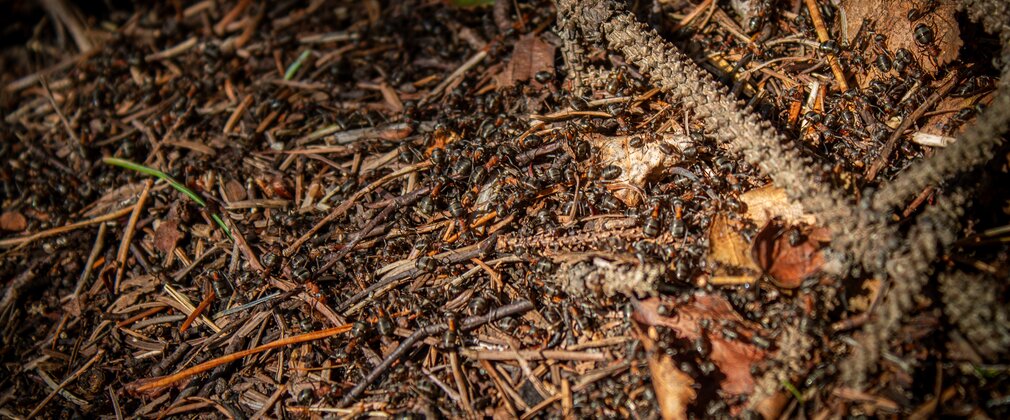
Wednesday 23 July 2025
Small but mighty ecosystem engineers move to Cumbria to boost nature’s recovery
Forestry England is testing a new approach to restoring nature in the nation's forests by moving colonies of hairy wood ants from a forest in North Yorkshire to a wild Cumbrian landscape, as part of its long-term vision for creating resilient woodland ecosystems.
A team has this week carefully relocated hairy wood ants from Cropton Forest in North Yorkshire, bringing the colonies to specially selected sites at Wild Ennerdale in Cumbria. They moved four nests, each containing thousands of ants. The experiment forms part of a wider strategy to restore fully functioning forest ecosystems across the country, bringing back lost wildlife species and supporting others to increase their populations.
The Forestry England team have used different methods for moving the ants in two stages. In the first phase, which took place in May, they moved six small, complete nests. They completed the second phase this week, which saw them moving the last of six much larger nests, allowing the remaining part of each nest to recover.
Early signs after the May translocation showed that the ant colonies were unaffected by the journey. The team saw that the ants were immediately active, moving their pupae to safety within the nest, and within a couple of days had spread out widely investigating their new environment.
Hayley Dauben, Forestry England Species Reintroduction Officer who is leading the project, said;
“The ants continued to surprise us in the first weeks after we moved them. We saw that they established new nests, some within a few metres of the translocated nest and some up to 30 metres away. We will closely monitor how well the colonies establish themselves in their new home in the months ahead, comparing results from the two translocation methods. And back in Cropton Forest, we’ll look at how the original nest sites recover. The next crucial milestone will be in April 2026 as the ants emerge from their period of winter hibernation.”
Despite their small size, hairy wood ants are important ecosystem engineers and can help create more resilient woodlands. They are a highly influential species and a dominant predator in the invertebrate world, protecting the flora and fauna they favour, and repelling or predating competitors. They create uneven invertebrate landscapes beneath and above the soil and in the tree canopy. Their large, mounded nests, which can be up to two metres high with extensive underground networks, create homes for over 100 ant-loving specialist species including beetles, hoverflies, mites, woodlice and other ants.
Wood ant nests are hot spots for nutrients and the warmer temperatures accelerate decomposition and nutrient cycling. The ants have a complex relationship with trees. They make nutrients more available for trees to grow, while they indirectly remove nutrients as they farm aphids in the canopy. They can reduce plant damage by keeping herbivorous pests away. However, other herbivores, with adapted ant-defences, can thrive. Hairy wood ant colonies can have many queens in a single nest and are supported by their daughter workers. Male wood ants live for only a short time to mate.
Monitoring by the University of York for over ten years has revealed that some forests such as Cropton Forest, have thriving populations of wood ants. These survived in isolated patches of ancient woodland and were able to colonise younger forests that are connected to them. Wood ants are slow and poor at dispersing, expanding to connected areas at a rate of only five metres a year. At Wild Ennerdale, there are six other species of ants, which occupy different ecological niches, but there were no colonies of wood ants.
Rachel Gardner, Species Recovery Manager, Forestry England, said;
“Wood ants are nature's own environmental engineers. By moving these remarkable insects to new areas, we're helping to rebuild complex forest communities that can better withstand future challenges, including extreme weather, climate change and pests and diseases. This trial will help us understand how we can restore nature's delicate balance across the nation’s forests in our care. We hope that the colonies we move will flourish in their new home and expand widely in time across the Wild Ennerdale landscape.
“Taking an experimental approach like this is an important part of the work we’re doing across the nation’s forests, exploring all the tools and techniques we can use to restore fully functioning ecosystems which flourish in the soil, above the ground and over our heads in the tree canopies.”
Dr Elva Robinson at the University of York has been a key advisor on the translocation. The university has supported the project by developing models to identify suitable sites in some of the nation’s 1,500 forests for further ant translocations. This scientific approach will help inform future nature recovery projects across the nation’s forests which Forestry England cares for. Starting in September, Forestry England will collaborate with the university to support a PhD to help study the wider impacts of this translocation on Wild Ennerdale.
All data from the trial will be made publicly available to help other organisations planning similar nature recovery projects, demonstrating Forestry England's commitment to open collaboration in nature restoration.
This initiative is part of Forestry England's long-term work in protecting and restoring resilient biodiversity across the nation’s 1,500 forests.
Notes to Editor
- Images are available here. Please credit Forestry England/Crown copyright.
- Forestry England manages and cares for the nation’s 1,500 woods and forests, with over 285 million visits in 2023/24. As England’s largest land manager, we shape landscapes and enhance forests for people to enjoy, wildlife to flourish and businesses to grow. We are continuing the work we have already started to make the nation’s forests resilient to climate change and by 2026 we will:
- create at least 6,000 more hectares where we integrate wilding activities in our productive forests
- increase the diversity of visitors to the nation’s forests and have one million hours of high-quality volunteer time given to the nation’s forests
- plant at least 2,000 hectares of new, high-quality woodlands
For more information visit forestryengland.uk. Forestry England is an agency of the Forestry Commission.
- Wild Ennerdale is a partnership between Forestry England, National Trust and United Utilities as the primary landowners, alongside Natural England. The partnership aims to allow the valley to evolve naturally for the benefit of people and wildlife.
Media contact:
Naomi Fuller, Media Relations Officer | media@forestryengland.uk
